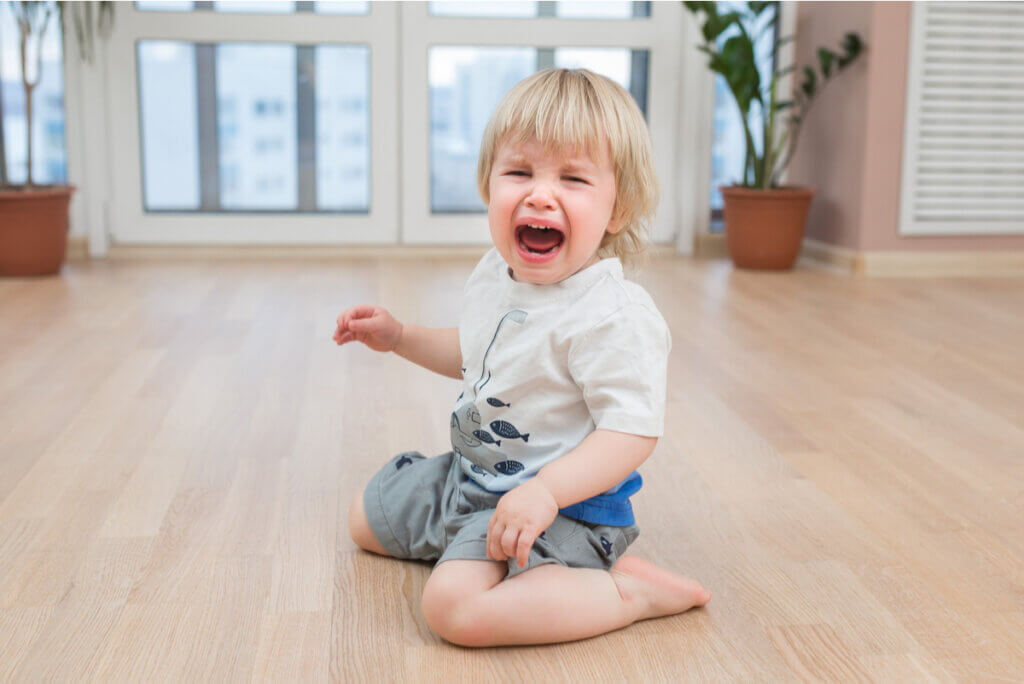Avoidant Attachment: What It Is and How It Affects Adulthood

In the middle of the last century, the British psychologist John Bowlby formulated the bases of what is now known as attachment theory. In summary, the theory suggests that the social and emotional development of a subject is conditioned by interpersonal experiences with a caregiver during childhood. The main types of attachment are secure, anxious, disorganized, and avoidant. Today we’ll talk to you about avoidant attachment and how it impacts adulthood.
The characteristics of avoidant attachment
Avoidant attachment, also known as dismissive attachment or insecure attachment, is characterized by the avoidance of parents or caregivers during early childhood.
Children who develop this type of attachment don’t manifest a preference between a caregiver and a complete stranger. They don’t show a special interest in their parents or those around them, despite depending on them for the essentials of daily life (shelter, food, and so on).
It was in the 1970s that Mary Ainsworth and Silvia Bell carried out an experiment known as the “strange situation procedure.” In it, the reactions of 56 babies were explored when their mothers left the room when they were playing. In the room, there was a caregiver trained to assess the reactions of the little ones to a stranger in the absence of their mother.
Infants with a secure attachment style would cry and develop distress after their mother left the room. On the other hand, those with an avoidant attachment style remained calm in the face of this action. This simple experiment illustrates what avoidant attachment is. We’ll review its main characteristics during childhood:
- Excess independence and autonomy when carrying out daily activities
- The tendency not to seek comfort from their parents (for example, in the face of a fall)
- Repression of feelings and emotions
- Fragile thoughts about themselves
- The tendency to reject physical contact with their parents
- The tendency to avoid eye contact with parents and caregivers
- The ability to maintain a certain calm in situations that arouse intense emotions
- An inclination to mistrust others
These are some of the most obvious signs of an avoidant attachment style. They manifest gradually, and all of them appear during childhood.
Despite the propensity not to seek affection or support from their parents or caregivers, children still develop anguish and stress in contexts in which they’re separated from them. The difference is that they don’t externalize it and show an apparent calm.
The causes of avoidant attachment

Attachment theory postulates that all types develop during early childhood. For evolutionary reasons, the natural tendency of children is to develop a secure attachment style.
The response of parents or caregivers is what shapes this type of attachment, as well as that of others. Therefore, when parents or caregivers express rejection or little attention when creating a secure bond, a distortion of the natural tendency to develop it appears.
Continued rejection causes little ones to repress their reactions to situations that cause anguish or stress. All this is because a certain reaction (like crying, for example) fails to trigger a certain response in the other person (parent or caregiver). When the latter isn’t emotionally available or doesn’t respond to reactions, the avoidant attachment style develops.
In this way, the little one not only represses their reaction to stressful contexts; their dependence on their parent or caregiver gradually decreases.
It can also appear when the little one does manifest the reactions, but the parent or caregiver punishes them or forces them to repress their reactions. According to the theory, the critical period for the consolidation of any attachment style ranges from six months to three years of age.
There are many reasons why a parent or caregiver shows little empathy or response to a certain reaction from their children. Frustration due to the parenting process, lack of empathy, lack of knowledge on how to approach some day-to-day situations of maternity and paternity, little sense of commitment, and, very importantly, the presence of their own avoidant attachment style.
The consequences of avoidant attachment in adulthood
So far, we’ve only alluded to avoidant attachment during childhood. Now that you know its causes and its features, you can understand the consequences it has on the day-to-day life of an adult.
As with other types of attachment, avoidance initially affects interpersonal relationships. That is, relationships with family, friends, colleagues, and those that develop in a romantic context.
Omitting many details, the fundamental feature of avoidant attachment is that individuals are uncomfortable with emotional closeness and intimacy as well as dependence on someone who’s part of their close circle. Based on this, we can delimit the following consequences in adult life.
Parenting experiences
A study published in Personality and Social Psychology Bulletin in 2006 found that parents with a dismissive or insecure attachment style experience increased stress after the birth of their child and perceive parenting as less fulfilling and personally meaningful. Due to all of this, they develop frustration, anguish, and even rejection of the experience. This can result in fostering avoidant attachment in their own children.
An excess of independence and autonomy in their relationships
We know that this style of attachment leads to an excess of autonomy in couple relationships. This translates into a tendency for individualism in decision-making planning activities, and distributing free time.
In general, those affected assume that seeking psychological or emotional closeness with their romantic partners isn’t desirable or even possible.
Negative opinions about their romantic partners

Experts suggest that avoidant people often have a negative opinion of their romantic partners. At first, they tend to think that they don’t love them, that they will abandon them at any moment, or that they’re prone to infidelity.
These beliefs are strengthened through others: Thinking that one is unworthy of love and not deserving of the support and attention of others.
A tendency to be unfaithful
A study published in the Journal of Personality and Social Psychology in 2011 found that people with an avoidant attachment style develop a greater tendency toward infidelity.
As they show a lower level of commitment in their romantic relationships, they may show less resistance to temptations to be unfaithful. Not surprisingly, some experts warn that the subjective well-being of a person with a partner with this type of attachment is lower.
Less willingness to ask for and offer help
We’ve already established that this type of attachment is characterized by independence and autonomy. Therefore, subjects are reluctant to ask for help in contexts in which they need it.
But this isn’t all. A study published in Personality and Individual Differences in 2015 suggested that they’re also less likely to offer help. This is because they perceive the costs of helping as more severe, which translates into less frequent altruistic behavior.
In practice, there are many consequences of this attachment style, but these are some of the most significant during adulthood.
As we already mentioned, it’s a type of attachment that’s established during childhood, although experiences in adolescence and adulthood help to reinforce it. When it negatively impacts a person’s day-to-day life, the therapeutic approach can be considered as a method to address all these traits.
In the middle of the last century, the British psychologist John Bowlby formulated the bases of what is now known as attachment theory. In summary, the theory suggests that the social and emotional development of a subject is conditioned by interpersonal experiences with a caregiver during childhood. The main types of attachment are secure, anxious, disorganized, and avoidant. Today we’ll talk to you about avoidant attachment and how it impacts adulthood.
The characteristics of avoidant attachment
Avoidant attachment, also known as dismissive attachment or insecure attachment, is characterized by the avoidance of parents or caregivers during early childhood.
Children who develop this type of attachment don’t manifest a preference between a caregiver and a complete stranger. They don’t show a special interest in their parents or those around them, despite depending on them for the essentials of daily life (shelter, food, and so on).
It was in the 1970s that Mary Ainsworth and Silvia Bell carried out an experiment known as the “strange situation procedure.” In it, the reactions of 56 babies were explored when their mothers left the room when they were playing. In the room, there was a caregiver trained to assess the reactions of the little ones to a stranger in the absence of their mother.
Infants with a secure attachment style would cry and develop distress after their mother left the room. On the other hand, those with an avoidant attachment style remained calm in the face of this action. This simple experiment illustrates what avoidant attachment is. We’ll review its main characteristics during childhood:
- Excess independence and autonomy when carrying out daily activities
- The tendency not to seek comfort from their parents (for example, in the face of a fall)
- Repression of feelings and emotions
- Fragile thoughts about themselves
- The tendency to reject physical contact with their parents
- The tendency to avoid eye contact with parents and caregivers
- The ability to maintain a certain calm in situations that arouse intense emotions
- An inclination to mistrust others
These are some of the most obvious signs of an avoidant attachment style. They manifest gradually, and all of them appear during childhood.
Despite the propensity not to seek affection or support from their parents or caregivers, children still develop anguish and stress in contexts in which they’re separated from them. The difference is that they don’t externalize it and show an apparent calm.
The causes of avoidant attachment

Attachment theory postulates that all types develop during early childhood. For evolutionary reasons, the natural tendency of children is to develop a secure attachment style.
The response of parents or caregivers is what shapes this type of attachment, as well as that of others. Therefore, when parents or caregivers express rejection or little attention when creating a secure bond, a distortion of the natural tendency to develop it appears.
Continued rejection causes little ones to repress their reactions to situations that cause anguish or stress. All this is because a certain reaction (like crying, for example) fails to trigger a certain response in the other person (parent or caregiver). When the latter isn’t emotionally available or doesn’t respond to reactions, the avoidant attachment style develops.
In this way, the little one not only represses their reaction to stressful contexts; their dependence on their parent or caregiver gradually decreases.
It can also appear when the little one does manifest the reactions, but the parent or caregiver punishes them or forces them to repress their reactions. According to the theory, the critical period for the consolidation of any attachment style ranges from six months to three years of age.
There are many reasons why a parent or caregiver shows little empathy or response to a certain reaction from their children. Frustration due to the parenting process, lack of empathy, lack of knowledge on how to approach some day-to-day situations of maternity and paternity, little sense of commitment, and, very importantly, the presence of their own avoidant attachment style.
The consequences of avoidant attachment in adulthood
So far, we’ve only alluded to avoidant attachment during childhood. Now that you know its causes and its features, you can understand the consequences it has on the day-to-day life of an adult.
As with other types of attachment, avoidance initially affects interpersonal relationships. That is, relationships with family, friends, colleagues, and those that develop in a romantic context.
Omitting many details, the fundamental feature of avoidant attachment is that individuals are uncomfortable with emotional closeness and intimacy as well as dependence on someone who’s part of their close circle. Based on this, we can delimit the following consequences in adult life.
Parenting experiences
A study published in Personality and Social Psychology Bulletin in 2006 found that parents with a dismissive or insecure attachment style experience increased stress after the birth of their child and perceive parenting as less fulfilling and personally meaningful. Due to all of this, they develop frustration, anguish, and even rejection of the experience. This can result in fostering avoidant attachment in their own children.
An excess of independence and autonomy in their relationships
We know that this style of attachment leads to an excess of autonomy in couple relationships. This translates into a tendency for individualism in decision-making planning activities, and distributing free time.
In general, those affected assume that seeking psychological or emotional closeness with their romantic partners isn’t desirable or even possible.
Negative opinions about their romantic partners

Experts suggest that avoidant people often have a negative opinion of their romantic partners. At first, they tend to think that they don’t love them, that they will abandon them at any moment, or that they’re prone to infidelity.
These beliefs are strengthened through others: Thinking that one is unworthy of love and not deserving of the support and attention of others.
A tendency to be unfaithful
A study published in the Journal of Personality and Social Psychology in 2011 found that people with an avoidant attachment style develop a greater tendency toward infidelity.
As they show a lower level of commitment in their romantic relationships, they may show less resistance to temptations to be unfaithful. Not surprisingly, some experts warn that the subjective well-being of a person with a partner with this type of attachment is lower.
Less willingness to ask for and offer help
We’ve already established that this type of attachment is characterized by independence and autonomy. Therefore, subjects are reluctant to ask for help in contexts in which they need it.
But this isn’t all. A study published in Personality and Individual Differences in 2015 suggested that they’re also less likely to offer help. This is because they perceive the costs of helping as more severe, which translates into less frequent altruistic behavior.
In practice, there are many consequences of this attachment style, but these are some of the most significant during adulthood.
As we already mentioned, it’s a type of attachment that’s established during childhood, although experiences in adolescence and adulthood help to reinforce it. When it negatively impacts a person’s day-to-day life, the therapeutic approach can be considered as a method to address all these traits.
- Ainsworth, M. D. S., & Bell, S. M. 5. Attachment, Exploration, and Separation: Illustrated by the Behavior of One-Year-Olds in a Strange Situation. In The life cycle. 1981; 57-71.
- Bartholomew, K. Avoidance of intimacy: An attachment perspective. Journal of Social and Personal relationships. 1990; 7(2): 147-178.
- DeWall, C. N., Lambert, N. M., Slotter, E. B., Pond Jr, R. S., Deckman, T., Finkel, E. J., … & Fincham, F. D. So far away from one’s partner, yet so close to romantic alternatives: avoidant attachment, interest in alternatives, and infidelity. Journal of personality and social psychology. 2011; 101(6): 1302.
- Li, T., & Fung, H. H. How avoidant attachment influences subjective well-being: An investigation about theageandgender differences. Aging & mental health. 2014; 18(1): 4-10.
- Mikulincer, M. Attachment working models and the sense of trust: An exploration of interaction goals and affect regulation. Journal of personality and social psychology. 1998; 74(5): 1209.
- Richman, S. B., DeWall, C. N., & Wolff, M. N. Avoiding affection, avoiding altruism: Why is avoidant attachment related to less helping?. Personality and Individual Differences. 2015; 76: 193-197.
- Rholes WS, Simpson JA, Friedman M. Avoidant attachment and the experience of parenting. Pers Soc Psychol Bull. 2006 Mar;32(3):275-85.
Este texto se ofrece únicamente con propósitos informativos y no reemplaza la consulta con un profesional. Ante dudas, consulta a tu especialista.







